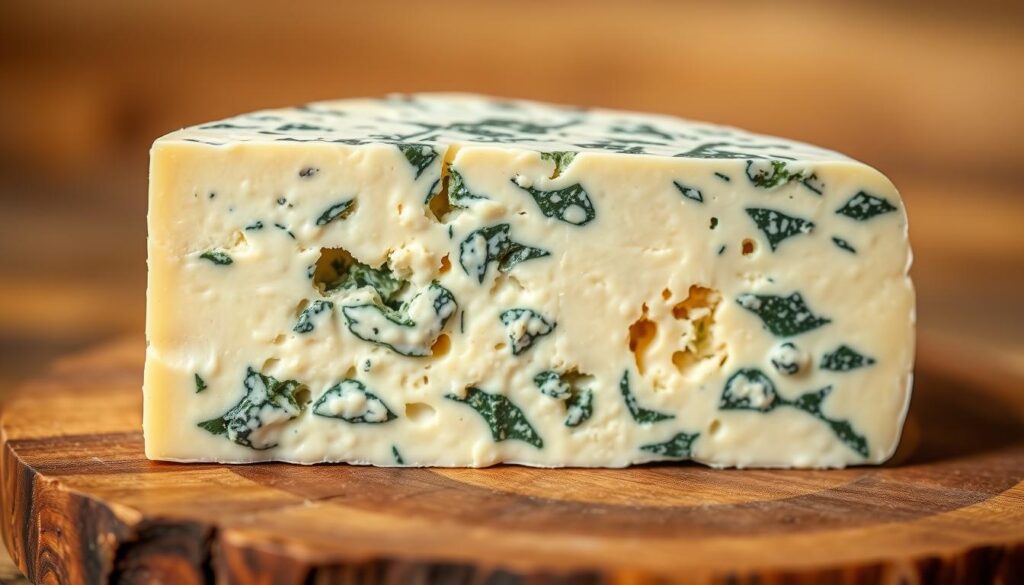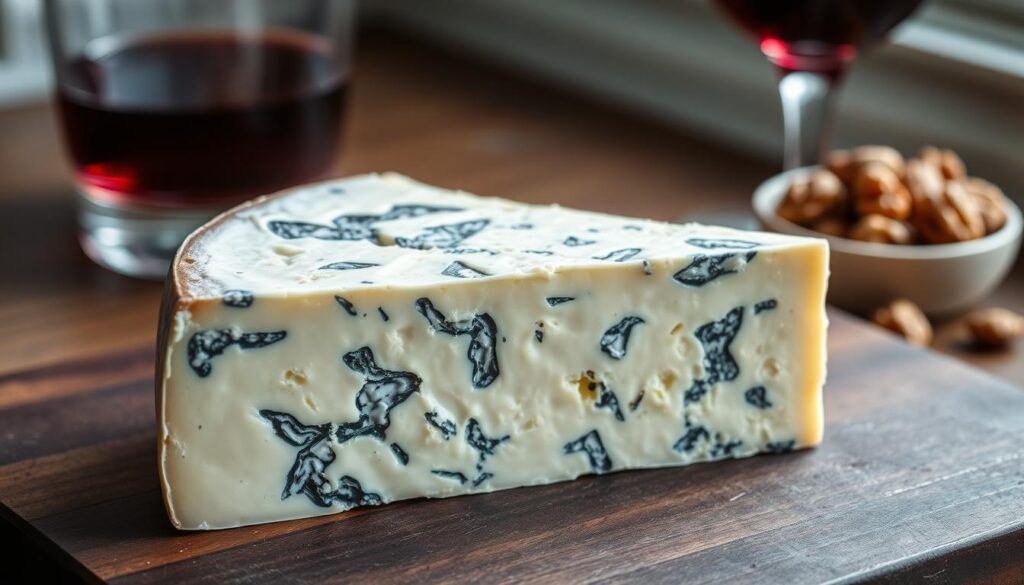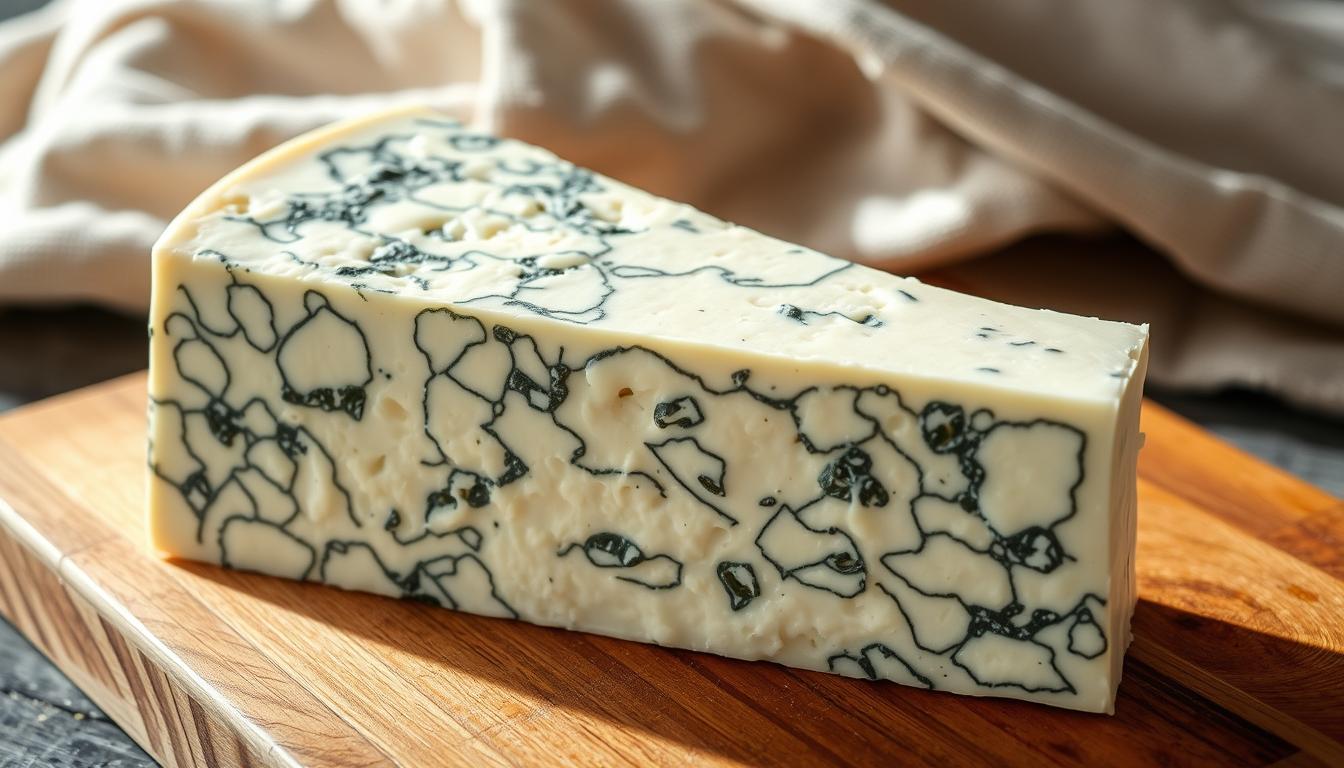The Ultimate Guide to Enjoying Gorgonzola Cheese
Gorgonzola cheese has a long history, dating back over 1,000 years. It originated in Gorgonzola, Italy, around the 9th or 10th century1. To learn more, you can visit Gorgonzola and explore its rich history. Gorgonzola is a blue cheese known for its creamy texture and tangy flavor. It’s a great addition to many dishes, including those found on cheesevibes websites.
Understanding Gorgonzola’s unique characteristics is key. It has blue-green veins that develop during aging1. Made from cow’s milk, it’s aged for several months. This gives it a distinctive flavor that’s both mild and sharp, depending on the type1.
In this article, we’ll explore Gorgonzola cheese’s history, production, types, and uses. We’ll also provide tips on how to store and serve it. Plus, we’ll discuss the benefits of enjoying Gorgonzola.
Key Takeaways
- Gorgonzola cheese has a rich history dating back over 1,000 years1.
- Gorgonzola is a type of blue cheese known for its creamy texture and tangy flavor1.
- The aging process for Gorgonzola ranges from 2 to 6 months, depending on the type1.
- Gorgonzola is made from cow’s milk and is a good source of protein and calcium1.
- Gorgonzola pairs well with a variety of foods, including fruits, nuts, and meats1.
- Gorgonzola cheese can be used in a variety of dishes, from appetizers to main courses1.
- Gorgonzola is a versatile cheese that can be enjoyed on its own or used as an ingredient in various recipes1.
What is Gorgonzola: A Rich History of Italy’s Blue-Veined Treasure
Gorgonzola, a famous Italian blue cheese, has roots going back to the 9th century. It comes from the town of Gorgonzola near Milan2. The cheese gets its blue-green veins from a special mold added to the curds. This makes Gorgonzola stand out from other cheeses, like Blue Cheese. It’s a tasty choice for those eager to try something new, including learning How to Eat Gorgonzola Cheese2.
The blue-green veins come from a natural mold that grows on the cheese. This gives it a rich, complex taste. Gorgonzola is protected by the Protected Designation of Origin (PDO) status. This means it can only be made in certain areas of Italy, including Gorgonzola2. This protection ensures it’s made with top-quality ingredients and traditional methods. It’s a favorite in many dishes and a great choice when comparing Gorgonzola vs Blue Cheese.
There are many ways to enjoy Gorgonzola, like pairing it with wine and other foods. Blue cheeses, like Gorgonzola, are often matched with sweet or savory items to balance their strong flavors. This is seen in competitions, like when American Rogue Creamery’s Rogue River Blue was named the best cheese in the world3. Gorgonzola’s versatility makes it a great addition to any meal. Its rich history and unique production make it a fascinating topic to explore.
The Distinctive Flavor Profile of Gorgonzola
Gorgonzola cheese has a unique taste that’s both tangy and creamy. The flavor changes based on the type, like Gorgonzola Dolce vs Gorgonzola Piccante4. It’s often described as earthy and nutty, with a hint of sweetness. The texture can be soft and creamy or firm and crumbly5.
Gorgonzola Dolce is milder and creamier. It’s perfect for those who don’t like strong blue cheeses. On the other hand, Gorgonzola Piccante is sharper and more intense4.
Gorgonzola is rich in protein and calcium. It has about 6.1 grams of protein per ounce and 12% of the daily calcium6. It’s almost all cow’s milk, with a special mold making it unique6. For more on Gorgonzola, check out Gorgonzola cheese and see the different types.
The aging time for Gorgonzola ranges from 2 to 9 months. This time affects the type of Gorgonzola made5. Sweet Gorgonzola ages for 50 to 150 days, while Spicy Gorgonzola ages for 80 to 270 days5. It’s gluten-free and packed with vitamins like B2, B6, and B125.
Gorgonzola must follow DOP rules. It’s made from pasteurized cow’s milk from specific regions in Italy4.

Gorgonzola Dolce and Gorgonzola Piccante taste differently. Gorgonzola Dolce is milder and creamier, while Gorgonzola Piccante is sharper4. Your choice depends on what you like, with Gorgonzola Dolce being good for those who dislike strong cheeses4.
Gorgonzola Varieties: Understanding the Different Types
Gorgonzola cheese comes in several varieties, each with its own unique flavor and texture. The two main types are Gorgonzola Piccante and Gorgonzola Dolce7. Gorgonzola Dolce is milder and creamier, while Gorgonzola Piccante is sharper and more intense8.
To create these distinct flavors, the cheese is aged for different periods. Gorgonzola Dolce is aged for 50 to 170 days7. Gorgonzola Piccante is aged for 80 to 270 days7.
Regional variations also affect the flavor and texture of Gorgonzola. It’s produced in Lombardy and Piedmont7. About 30 dairies make Gorgonzola7. The blue mold culture used is Penicillium roqueforti, with two sub-varieties7.
When making Gorgonzola Cheese Recipes, knowing the different types is key. It helps create the perfect dish.
- Gorgonzola Dolce: mild and creamy, aged for 50-170 days7
- Gorgonzola Piccante: sharp and intense, aged for 80-270 days7
- Regional variations: Lombardy and Piedmont7
To explore moreGorgonzola Cheese Recipes, it’s essential to consider the unique flavor profiles of each variety. Whether you’re looking for a mild and creamy cheese or a sharp and intense one, Gorgonzola has a variety to suit every taste8.
How to Select and Store Your Gorgonzola
To pick a good Gorgonzola cheese, look for one that’s creamy and has a mild taste9. Stay away from cheeses that are too strong or bitter. Gorgonzola is packed with protein, calcium, and probiotics, making it a healthy choice. It’s a great addition to a balanced diet, as it answers the question of Is Gorgonzola Cheese Healthy?10.
Keep Gorgonzola cheese in the fridge, wrapped in plastic or foil9. It’s key to keep the right temperature and humidity to keep its flavor and texture good.
Here are some tips for storing Gorgonzola cheese:
- Wrap the cheese loosely in parchment or wax paper9
- Store it in the refrigerator at a consistent temperature11
- Avoid using plastic wrap, as it can affect the cheese’s flavor and texture9

Gorgonzola cheese goes well with sweet flavors like honey and fruits. It’s also great in salads with bitter greens like frisee, endive, and radicchio9. You can melt it into dishes like risotto or polenta for a salty kick9. With its creamy yet crumbly texture and tangy taste, Gorgonzola is a fantastic addition to any meal. Its health benefits make it a great choice for those wondering Is Gorgonzola Cheese Healthy?10.
Perfect Pairings: What to Serve with Gorgonzola
Gorgonzola cheese goes well with many foods and drinks. For wine, try a dry white like Pinot Grigio or a rich red like Cabernet Sauvignon12. For more pairing ideas, check out this cheese pairing guide. It also pairs well with fruit like pears or apples, and nuts like walnuts or almonds12.
Some favorite pairings include Gorgonzola with pears, walnuts, and honey12. Gorgonzola must come from Italy’s Lombardy region13. It has two types: mountain Gorgonzola (bold, crumbly) and Gorgonzola dolce (creamy, sweet)13.
To make a great cheese board, pair Gorgonzola with cheeses like Parmesan or Mozzarella. Add crackers or bread for a quick snack. Here are some foods that go well with Gorgonzola:
- Fresh fruits, such as figs, pears, apples, kiwis, and strawberries12
- Nuts, such as walnuts or almonds12
- Jams, marmalades, and mustards, like chestnut or fig mustards12
- Honey, like acacia or spring flower honey12
- Dry white wine, such as Pinot Grigio12
- Rich red wine, such as Cabernet Sauvignon12
- Classic Belgian abbey beers12
- Trappist beers, like Chimay bleu and Leffe12
Cooking with Gorgonzola: Tips and Techniques
Gorgonzola vs Blue Cheese is a debate among cheese lovers. But Gorgonzola is great for many dishes, like pasta sauces and salads14. Use it sparingly because it’s strong. Add it to pasta sauces, like carbonara or creamy tomato, to let its flavor stand out14.
Gorgonzola tastes more nuanced and slightly sweet than Blue Cheese. It’s perfect for farfalle with creamy mushroom sauce, adding a sharp bite14. It also pairs well with Italian ingredients like prosciutto and fig jam in gourmet pizzas14.
Here are some ways to use Gorgonzola in cooking:
- Fried Gorgonzola makes a simple green salad more interesting14
- Gorgonzola dressings, like in greens with Gorgonzola dressing, show its versatility in both Italian and American cuisine14
- It’s a key ingredient in winter squash wedges, salad pizza, and macaroni and cheese14
When cooking with Gorgonzola, balance its flavor with other ingredients. For example, in golden beet carpaccio, high-quality Gorgonzola is key for success14. Knowing the differences between Gorgonzola and Blue Cheese helps you make delicious dishes with its rich flavor.
Essential Gorgonzola Recipes for Every Occasion
Gorgonzola cheese is great for many dishes, like pasta, risotto, sauces, and dressings. You can make a quick Gorgonzola pasta dish, like spaghetti carbonara with Gorgonzola and bacon15. It’s also good in creamy risotto with mushrooms16.
A Gorgonzola sauce is a favorite. It’s perfect for tossing with penne pasta or as a dip for steak or veggies. To make it, you need Gorgonzola, heavy cream, and butter. You can change the sauce’s thickness by adjusting the cream and cheese15. Adding toasted walnuts or spinach can make it taste richer16.
Here are some tips for making the perfect Gorgonzola sauce:
- Use high-quality Gorgonzola cheese for the best flavor17.
- Adjust the amount of cream to achieve the desired thickness15.
- Add some seasoning, such as salt and pepper, to taste16.
For more info on Gorgonzola Cheese Recipes, check out this website or this website. These tips and recipes will help you make delicious Gorgonzola dishes that will wow your guests17.
Conclusion: Embracing the Complex World of Gorgonzola
Gorgonzola cheese is a treasure that has amazed people for centuries. It comes from the northern Italian areas of Piedmont and18. This cheese has a long history, dating back to the 9th century, making it one of the oldest blue-veined cheeses in the world19.
The cheese has a creamy texture and a bold, tangy taste. It’s great on its own, in recipes, or as the star of a cheese board. With its Protected Designation of Origin (DOP) status19, you know you’re getting the real deal.
Start your Gorgonzola adventure and enjoy its complex flavors. Try the sweet Gorgonzola Dolce or the sharp Gorgonzola Piccante. The choices are endless19. So, experiment and find out the magic of Gorgonzola – a true Italian cheesemaking masterpiece.
FAQ
What is Gorgonzola Cheese?
Gorgonzola cheese comes from Italy. It’s made from cow’s milk. It’s creamy and tangy, with blue-green veins.
What is the difference between Gorgonzola and Blue Cheese?
Gorgonzola is a specific Italian blue cheese. Blue cheese is a broader term for cheeses with blue-green veins. Gorgonzola has its own taste and making process, making it unique.
How should I eat Gorgonzola Cheese?
You can enjoy Gorgonzola in many ways. Eat it alone, with fruits, nuts, or crackers. It’s also great in pasta, risotto, and salads.
What is the difference between Gorgonzola Dolce and Gorgonzola Piccante?
Gorgonzola Dolce is milder and creamier. Gorgonzola Piccante is sharper. The aging process and mold type cause these differences.
What are some Gorgonzola Cheese Recipes?
You can make many dishes with Gorgonzola. Try Gorgonzola pasta, risotto, salad, and sauces.
Is Gorgonzola Cheese Healthy?
Gorgonzola can be healthy in small amounts. It has protein, calcium, and probiotics. But, it’s high in fat and sodium, so eat it carefully.







